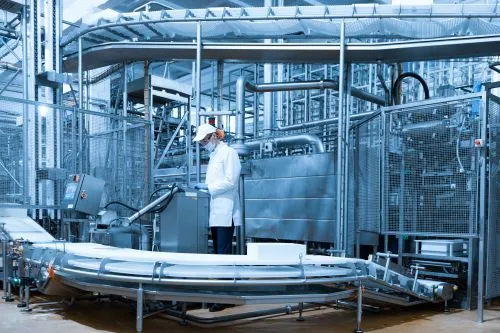
Keeping calves with their mothers for longer periods after birth has always been a controversial topic for dairy farmers, citing concerns about costs, logistics, and practical aspects, according to a DairyGlobal presentation of a research study conducted in Israel.
Health Benefits
Those in favor of the practice argue that there are health and welfare benefits for both the mother and offspring, as well as potential improvements in milk quality in the future. A project underway in Israel, called Natural Dairy Farming, examines exactly what the practice entails in reality, as it keeps the cow and calf together for 3 months.
The project leader and veterinarian, Dr. Sivan Lacker, said that animal welfare can be increased overall, and profits can be maintained with the potential to increase milk quality.
She began the project on a 90-cow farm in northern Israel and hopes that the benefits found can encourage other farmers to try the same.
"I founded my company, Mutual Dairy Farming, in 2013 with a clear vision of improving the welfare of cows and calves in the dairy product industry. Much of what we do focuses on the farmer's mindset by developing an awareness of the behavioral needs of cows.
Practical Changes
This leads to practical changes in welfare and supports farmers with training sessions and follow-up visits," said Lacker. "In the last 5 years, we have collaborated with 2 large dairy product cooperatives, working closely with about 60 of their dairy farms.
There has been fundamental progress in improving welfare; however, I have always felt that the next step is to keep cows and calves together. Separating the calf from the cow has always been a point of contention for me.
Prioritizing the development of a mother-calf bond and early life together is the most basic behavioral need for both animals," she said, adding that denying this possibility is a violation of animal welfare and introduces potential stress effects, which can be reduced and even eliminated.
Unique Method
Sivan is a veterinarian who has been practicing for 14 years and has focused more closely on animal welfare in the last 10 years.
During this time, she has gained a good understanding of the behavioral needs of cows and wanted to explore practices that would improve the health of cows and calves, reduce stress levels, improve the welfare of cows and calves, and remain economically viable.
Sivan adds, "In 2019, I traveled to Europe to visit organic farms that raise calves and cows together. I wanted to learn firsthand from farmers who have been using these methods for many years and to gain a deeper understanding of the advantages and challenges of this system.
"At the same time, I kept abreast of most of the research published in recent years regarding cow-calf interaction. These sources created the source from which my passion for taking a leadership role in this field arises. I have managed to create a unique method that meets all these criteria."
Natural Behavior
Traditionally, most dairy farmers worldwide separate the calf from the cow at birth. Usually, cows are allowed to lick the calf to help it recover after birth and to help it stand up. Calves are then taken to rearing pens to be fed and cared for by the farmer, thus eliminating the chance of forming any strong bond.
Traditionally, it has been argued that the longer cows and calves spend together, the deeper the mutual bond and the more intense the stress of being separated. On the other hand, research shows that there are long-term benefits of prolonged contact in terms of sociability, fear, and future maternal behavior.
Health, weight gain, and future productivity are also improved when calves are allowed to spend more time with the cow. Sivan says:
"In my program, we leave them together for about 3 months and then begin a gradual weaning protocol, which I have developed. It has been proven that allowing natural behavior reduces stress and frustration levels both from the cow and the calf. Stress has a significant impact on health, milk production, milk quality, weight gain, and fertility.
When my system is implemented correctly, with the appropriate structural changes, it makes the farmer's life easier and effectively reduces working time. There is no need to move the calf to a new pen, thaw and feed it colostrum, clean the pen every few days, feed it up to 3 times a day, clean and wash the bottle and bucket after each feeding.
By eliminating these management steps, the farmer saves time because all he has to do is supervise and ensure that the calf is nursing and gaining weight." Both the cow and the calf can achieve better health and welfare when kept together.
Basic Freedoms
Other advantages of the system are that the calf has more freedom of movement than it would in a small pen. Also, calves should thrive better with fewer cases of diarrhea if managed correctly. Fewer cases of mastitis in cows have been reported, with fewer cases of metritis and retained placenta. Some farmers have expressed concern that they would have less milk for processing if calves were kept on cows and fed longer. The veterinarian comments:
"It's all about how the system functions and is managed. Calves are capable of nursing up to 10 liters of milk per day. During the time they stay with the cows, the farmer will have less milk to sell. At some point, the weaning process begins and, of course, milk consumption decreases. It all depends on the chosen protocol.
"There are several important factors present that offset this short-term loss. The milk consumed by a calf while with the mother cow would have been given to it anyway in rearing pens, either with whole milk from the tank or through milk replacer powder.
This is an expense the farmer takes into account when creating budgets. Additionally, there are significant economic advantages allowed by reducing cases of illness.
"Research also shows that, after weaning, cows that were nursed continue to produce higher yields than those that were not. Therefore, the farmer literally receives a part of the lost milk," she notes.
Global Aim
Sivan says her goal has always been to improve calf welfare on dairy farms, but she also realizes that it is equally important for the changes she suggests not to become a burden for the farmer.
"Operational changes should make life easier," she adds. "The increased outcomes recorded by improving the welfare of cows and calves must be looked at. However, mass implementation may not be pragmatic in certain cases.
Natural dairy farming can be implemented in farms in Israel and worldwide. It requires responsibility and professional guidance, and I am excited to be involved in every step of the process." (Photo: Freepik)





